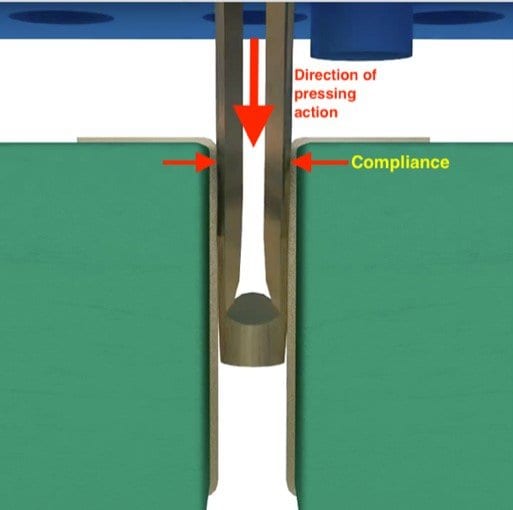PosiBlog
Press-fit Connectors Reduce Challenges in the Circuit Board Assembly Environment
by Gaby Cristian Mindreci, Director of EMEA Sales at Positronic
Attaching electrical contacts to printed circuit boards (PCB) is a complex process. Establishing solid, reliable connections on a somewhat delicate and often crowded circuit board, without damaging or compromising it, constitutes a technical challenge. The primary method for attaching components to PCBs is soldering, and the electronics industry adopted specifications that outline precise in-process and inspection requirements related to soldering.
With soldering, however, engineers identify areas of concern because up to twelve types of solder anomalies known as Class-2 defects could occur during processing and cause rejection of the entire PCB assembly. Moreover, the elimination of lead-free solder introduced its own set of problems due to higher processing temperatures.
In the 1960’s, connectors with various shapes of press-fit terminations began to appear, and press-fit technology started to evolve as an alternative to the soldering method.

Press fit mounting example
As suggested by their name, press-fit contacts are pressed into properly dimensioned plated-through holes on the PCB with gas-tight interference between the contact and the hole.
The telecommunications industry was first to adopt this method of connection in large scale applications in the late 1970s, and many specifications have been written around press-fit performance requirements by various industry groups such as IEC (International Electrotechnical Commission), Bellcore (Bell Communications Research) and PICMG (PCI Industrial Computers Manufacturers Group).
Product development aimed to meet or exceed conformance to these specifications enabled connector manufacturers to gain significant expertise. That led to securing product design-in position in the aerospace sector through the late 2000s. Modern aircraft such as the Boeing 787 and the Airbus A350 are currently utilizing sophisticated power distribution and control systems that employ press-fit D-sub (D-subminiature) connectors manufactured by Positronic.
Press-fit is mechanically more stable and gas-tight connections are more secure than soldered connections, with a failure in time (FIT) tested at up to 30 times better than soldered connections.
Press-fit connectors are easily repaired, more environmentally friendly, and cost effective. Although press-fit eliminate the risks associated with soldering, this technology has its own challenges, and manufacturers compete with a spectrum of connector products offering press-fit terminations of various design complexities, made from materials with different performance levels.
Let’s take a closer look. There are different types of press-fit connectors, including those with solid pins (which remain rigid during insertion) and compliant pins (which compress or “comply” during insertion). Solid press-fit technology came first, but designers and manufacturers were concerned about the board damage caused by solid press-fit contacts.

Action of compliant contact design
To combat the problem, compliant press-fit technology was developed, and today compliant pins are generally preferred because they are less demanding on the PCB, require less force during the insertion process, and produce more reliable results.
Positronic takes compliant press-fit technology one step further with its bi-spring power press-fit terminations offering one-piece machined contact from tip to tail. Some manufacturers make a solid machined mating face and a stamped press termination.
The two are crimped and the joint is hidden in the insulator. The one-piece contact increases reliability. All size contacts, straight and 90º, manufactured by Positronic are one-piece construction.
Although the bi-spring design, known as the eye of the needle, is also made by other manufacturers, the precision of the execution is important to obtain a gas-tight (oxygen free) connection for reliable long-term performance. The bi-spring Positronic termination and the Omega designs are used in connectors qualified to the CPCI 2.11 and ATCA 3.0 specifications, which require survival through brutal mixed flowing gas testing, a test method using highly corrosive gasses in humid environment for specific durations of time.

Press-fit contact sizes available from Positronic
Another major advantage offered by the bi-spring and Omega compliant terminations is repeatability. The connector could be extracted and reused up to three times and the plating on the inner wall of the PCB through-hole is not entirely scraped off. If a connector is damaged, it can be replaced without causing damage to the PCB.
Press-fit terminations on a connector pose another significant advantage: the same part number could be installed on PCBs of various thickness, whereas solder tails must protrude past the bottom of the PCB by a minimum of 30 thousands of an inch, so proper wetting could occur. This means that various PCB thickness will require different connector part numbers.
Press-fit connectors are utilized in many applications, from data and communication to transportation and mechanics, and in either passive or harsh environments. Press-fit connectors are ideal for high current applications, whether it’s a continuous, peak or spike current. The high mechanical stability works well for heavy cables, and any torque will get better results from press-fit parts. It also works well for applications with high environmental impact, such as temperature or vibration.
Positronic has been involved with PICMG in industry group development of press-fit connectors for power and signal applications since the 1990s. Positronic’s latest generation of connector products using compliant, low-force repeatable press-fit terminations spreads across different power, signal and mixed density connectors. The machined contacts always employ a solid one-piece construction from tip to tail for both straight and 90-degree contact configurations.
Positronic press-fit technology is currently under qualification for spaceflight applications by the European Space Agency.

Various connector series from Positronic employing press-fit contacts
Latest Posts
- A Series Backshell Product Derivative: Introducing Precision Machined Banded Backshells March 12, 2024
- Exploring the E-Mobility Market with Positronic Connectors December 1, 2023
- Positronic Announces EL Series Aluminum Backshells August 7, 2023
- Positronic Releases New Zinc Die-Cast Backshell Series July 26, 2023
- Why Are Semiconductors So Vulnerable to Supply Chain Shortages? July 7, 2023